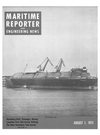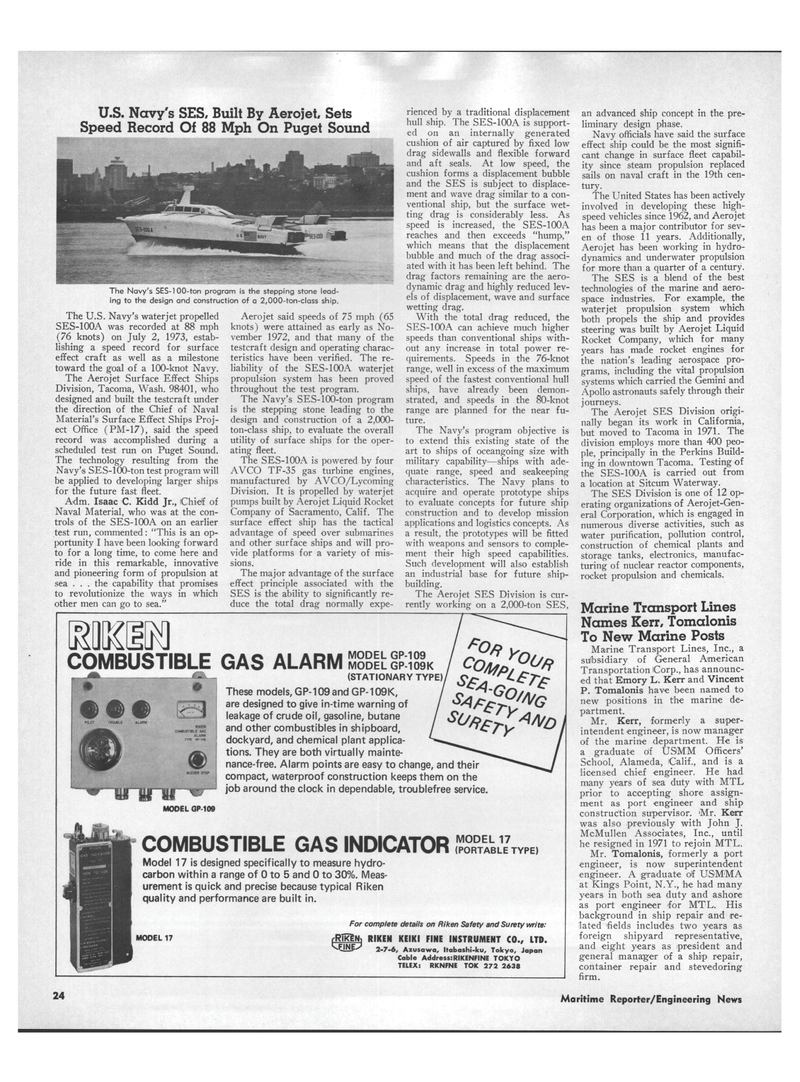
Page 22: of Maritime Reporter Magazine (August 1973)
Read this page in Pdf, Flash or Html5 edition of August 1973 Maritime Reporter Magazine
U.S. Navy's SES, Built By Aerojet, Sets
Speed Record Of 88 Mph On Puget Sound
The Navy's SES-100-ton program is the stepping stone lead- ing to the design and construction of a 2,000-ton-class ship.
The U.S. Navy's water jet propelled
SES-100A was recorded at 88 mph (76 knots) on July 2, 1973, estab- lishing a speed record for surface effect craft as well as a milestone toward the goal of a 100-knot Navy.
The Aerojet Surface Effect Ships
Division, Tacoma, Wash. 98401, who designed and built the testcraft under the direction of the Chief of Naval
Material's Surface Effect Ships Proj- ect Office (PM-17), said the speed record was accomplished during a scheduled test run on Puget Sound.
The technology resulting from the
Navy's SES-lOO-ton test program will be applied to developing larger ships for the future fast fleet.
Adm. Isaac C. Kidd Jr., Chief of
Naval Material, who was at the con- trols of the SES-100A on an earlier test run, commented: "This is an op- portunity I have been looking forward to for a long time, to come here and ride in this remarkable, innovative and pioneering form of propulsion at sea . . . the capability that promises to revolutionize the ways in which other men can go to sea."
Aerojet said speeds of 75 mph (65 knots) were attained as early as No- vember 1972, and that many of the testcraft design and operating charac- teristics have been verified. The re- liability of the SES-100A waterjet propulsion system has been proved throughout the test program.
The Navy's SES-lOO-ton program is the stepping stone leading to the design and construction of a 2,000- ton-class ship, to evaluate the overall utility of surface ships for the oper- ating fleet.
The SES-100A is powered by four
AVCO TF-35 gas turbine engines, manufactured by AVCO/Lycoming
Division. It is propelled by waterjet pumps built by Aerojet Liquid Rocket
Company of Sacramento, Calif. The surface effect ship has the tactical advantage of speed over submarines and other surface ships and will pro- vide platforms for a variety of mis- sions.
The major advantage of the surface effect principle associated with the
SES is the ability to significantly re- duce the total drag normally expe- rienced by a traditional displacement hull ship. The SES-100A is support- ed on an internally generated cushion of air captured by fixed low drag sidewalls and flexible forward and aft seals. At low speed, the cushion forms a displacement bubble and the SES is subject to displace- ment and wave drag similar to a con- ventional ship, but the surface wet- ting drag is considerably less. As speed is increased, the SES-100A reaches and then exceeds "hump," which means that the displacement bubble and much of the drag associ- ated with it has been left behind. The drag factors remaining are the aero- dynamic drag and highly reduced lev- els of displacement, wave and surface wetting drag.
With the total drag reduced, the
SES-100A can achieve much higher speeds than conventional ships with- out any increase in total power re- quirements. Speeds in the 76-knot range, well in excess of the maximum speed of the fastest conventional hull ships, have already been demon- strated, and speeds in the 80-knot range are planned for the near fu- ture.
The Navy's program objective is to extend this existing state of the art to ships of oceangoing size with military capability—ships with ade- quate range, speed and seakeeping characteristics. The Navy plans to acquire and operate prototype ships to evaluate concepts for future ship construction and to develop mission applications and logistics concepts. As a result, the prototypes will be fitted with weapons and sensors to comple- ment their high sp>eed capabilities.
Such development will also establish an industrial base for future ship- building.
The Aerojet SES Division is cur- rently working on a 2,000-ton SES, an advanced ship concept in the pre- liminary design phase.
Navy officials have said the surface effect ship could be the most signifi- cant change in surface fleet capabil- ity since steam propulsion replaced sails on naval craft in the 19th cen- tury.
The United States has been actively involved in developing these high- speed vehicles since 1962, and Aerojet has been a major contributor for sev- en of those 11 years. Additionally,
Aerojet has been working in hydro- dynamics and underwater propulsion for more than a quarter of a century.
The SES is a blend of the best technologies of the marine and aero- space industries. For example, the waterjet propulsion system which both propels the ship and provides steering was built by Aerojet Liquid
Rocket Company, which for many years has made rocket engines for the nation's leading aerospace pro- grams, including the vital propulsion systems which carried the Gemini and
Apollo astronauts safely through their journeys.
The Aerojet SES Division origi- nally began its work in California, but moved to Tacoma in 1971. The division employs more than 400 peo- ple, principally in the Perkins Build- ing in downtown Tacoma. Testing of the SES-100A is carried out from a location at Sitcum Waterway.
The SES Division is one of 12 op- erating organizations of Aerojet-Gen- eral Corporation, which is engaged in numerous diverse activities, such as water purification, pollution control, construction of chemical plants and storage tanks, electronics, manufac- turing of nuclear reactor components, rocket propulsion and chemicals.
Marine Transport Lines
Names Kerr, Tomalonis
To New Marine Posts
Marine Transport Lines, Inc., a subsidiary of General American
Transportation Corp., has announc- ed that Emory L. Kerr and Vincent
P. Tomalonis have been named to new positions in the marine de- partment.
Mr. Kerr, formerly a super- intendent engineer, is now manager of the marine department. He is a graduate o'f U9MM Officers'
School, Alameda, Calif., and is a licensed chief engineer. He had many years of sea duty with MTL prior to accepting shore assign- ment as port engineer and ship construction supervisor. Mr. Kerr was also previously with John J.
McMullen Associates, Inc., until he resigned in 1971 to rejoin MTL.
Mr. Tomalonis, formerly a port engineer, is now superintendent engineer. A graduate olf USM'MA at Kings Point, N.Y., he had many years in both sea duty and ashore as port engineer for MTL. His background in ship repair and re- lated fields includes two years as foreign shipyard representative, and eight years as president and general manager of a ship repair, container repair and stevedoring firm.
MUM COMBUSTIBLE GAS ALARM • • • mor Tft««Ls alarm
COMBUSTIBLE MS
ALARM rm «M8» 8L8ZES STOP
MODEL GP-109
MODEL GP-109K (STATIONARY TYPE)
These models,GP-109andGP-109K, are designed to give in-time warning of leakage of crude oil, gasoline, butane and other combustibles in shipboard, dockyard, and chemical plant applica- tions. They are both virtually mainte- nance-free. Alarm points are easy to change, and their compact, waterproof construction keeps them on the job around the clock in dependable, troublefree service.
S(Jft£ryAAjo
MODEL GP-109
COMBUSTIBLE GAS INDICATOR JS^i7™,
Model 17 is designed specifically to measure hydro- carbon within a range of 0 to 5 and 0 to 30%. Meas- urement is quick and precise because typical Riken quality and performance are built in.
MODEL 17 (-RTKEN1
MQne?
For complete details on Riken Safety and Surety write:
RIKEN KEIKI FINE INSTRUMENT CO., LTD. 2-7-6, Azusawa, Itabashi-ku, Tokyo, Japan
Cable Address:RIKENFINE TOKYO
TELEX: RKNFNE TOK 272 2638 24 Maritime Reporter/Engineering News

 21
21

 23
23
